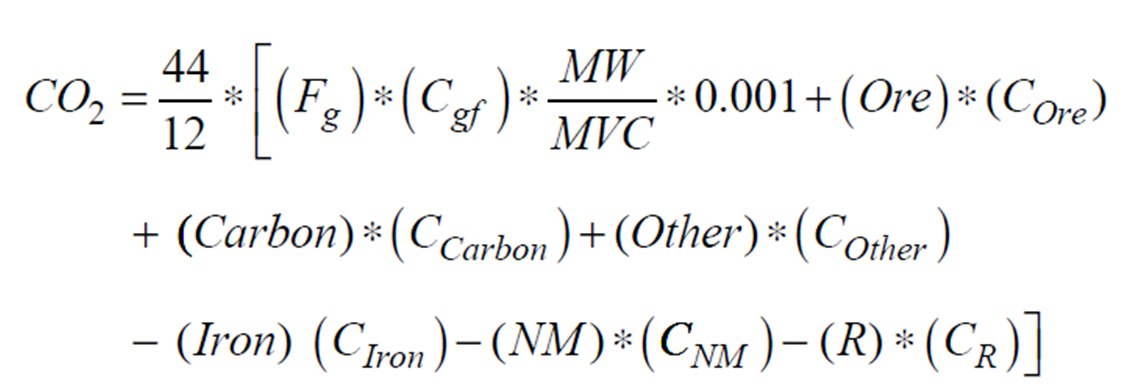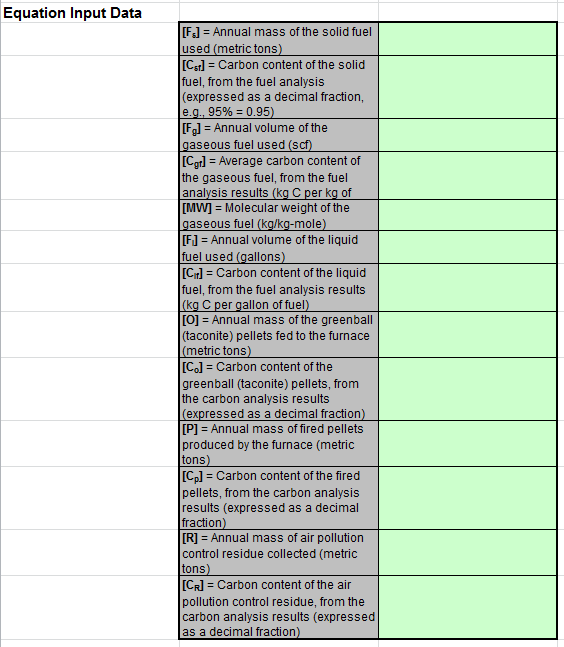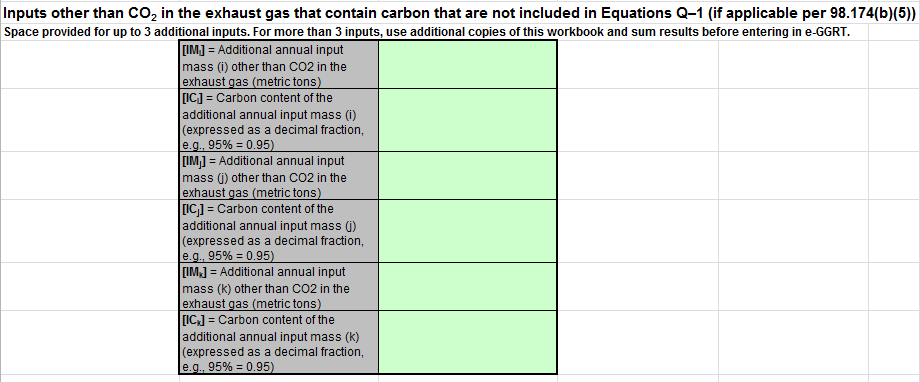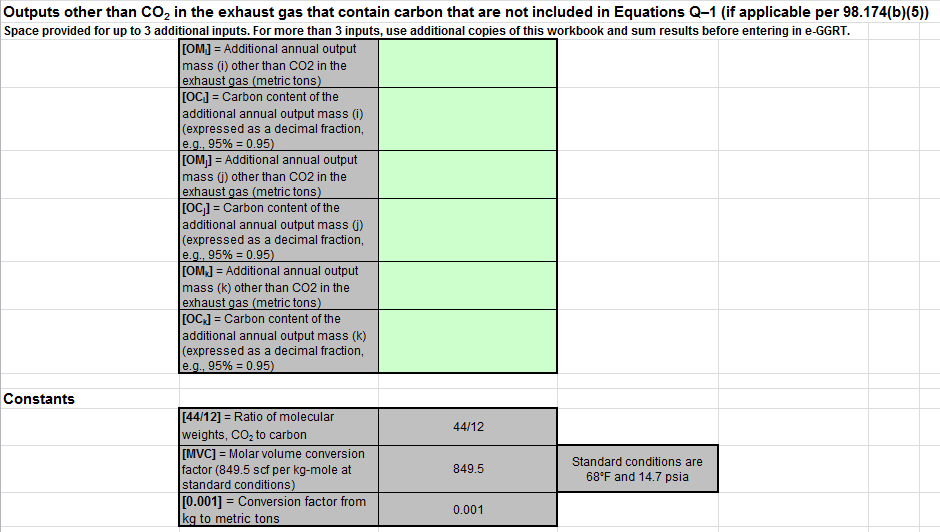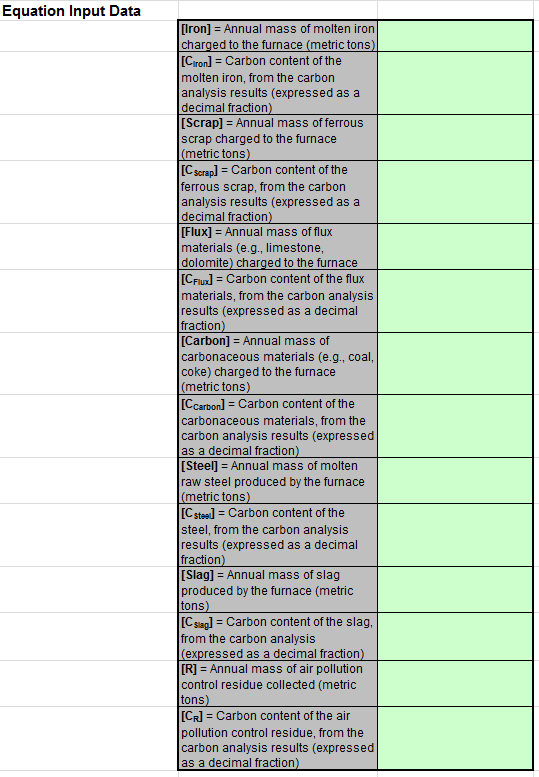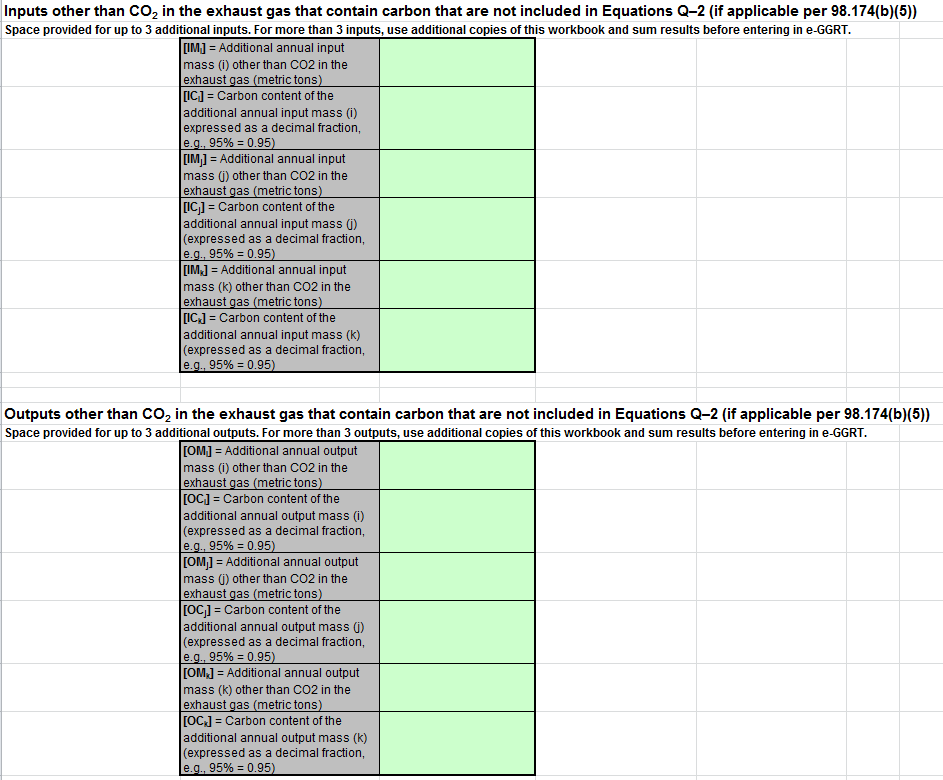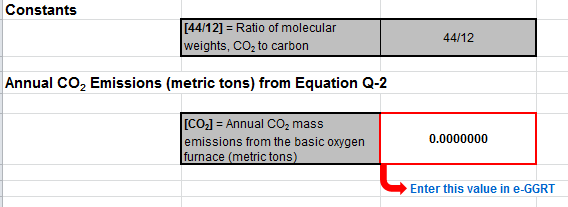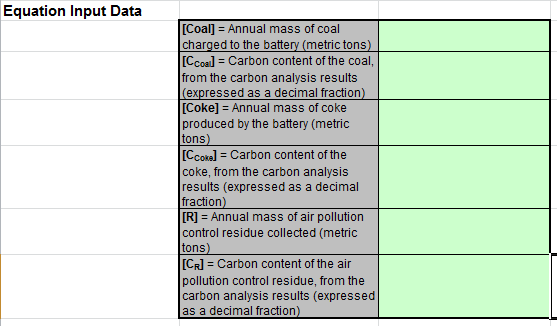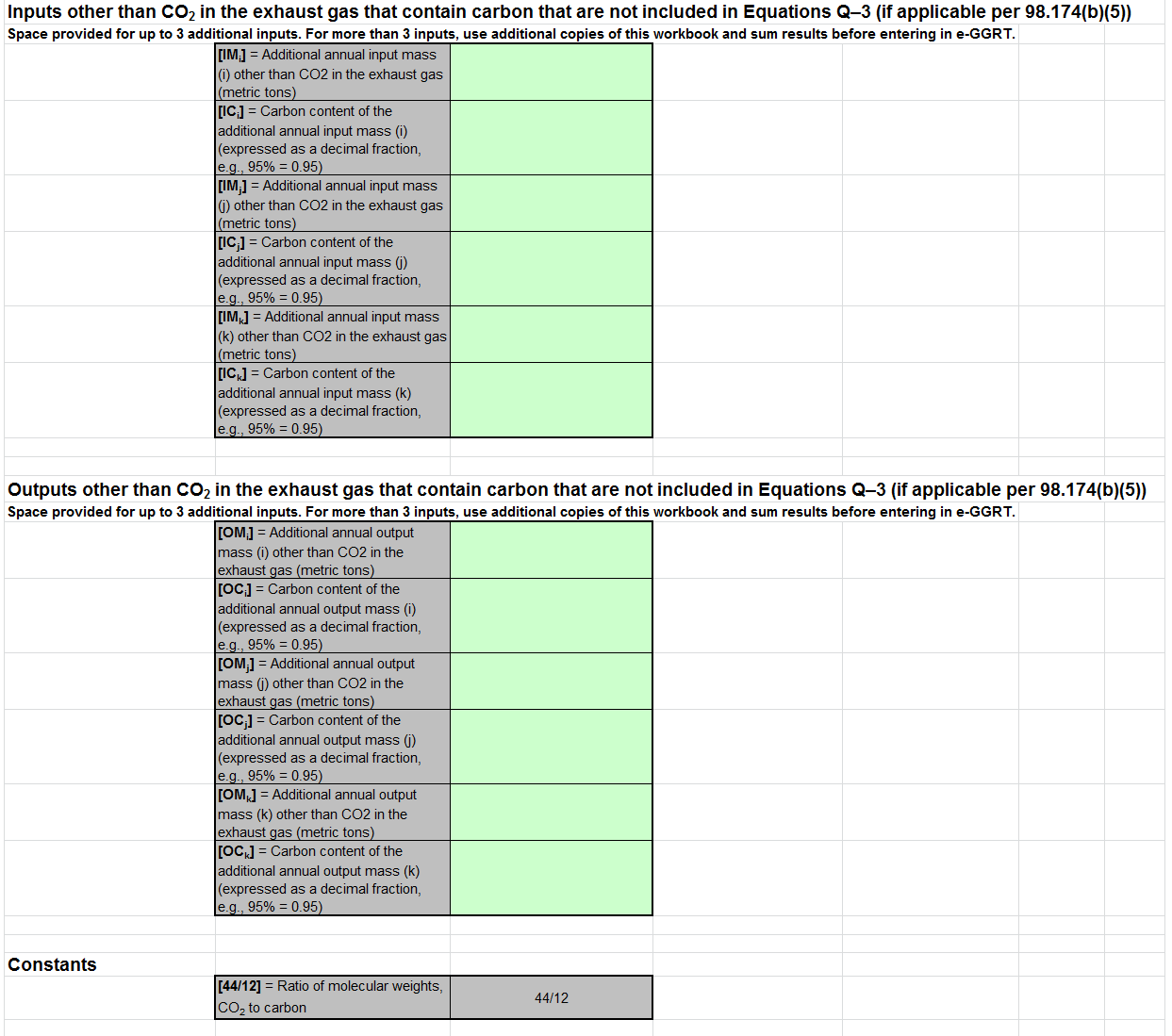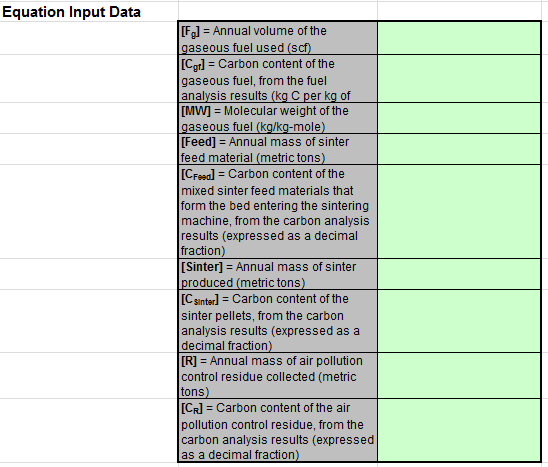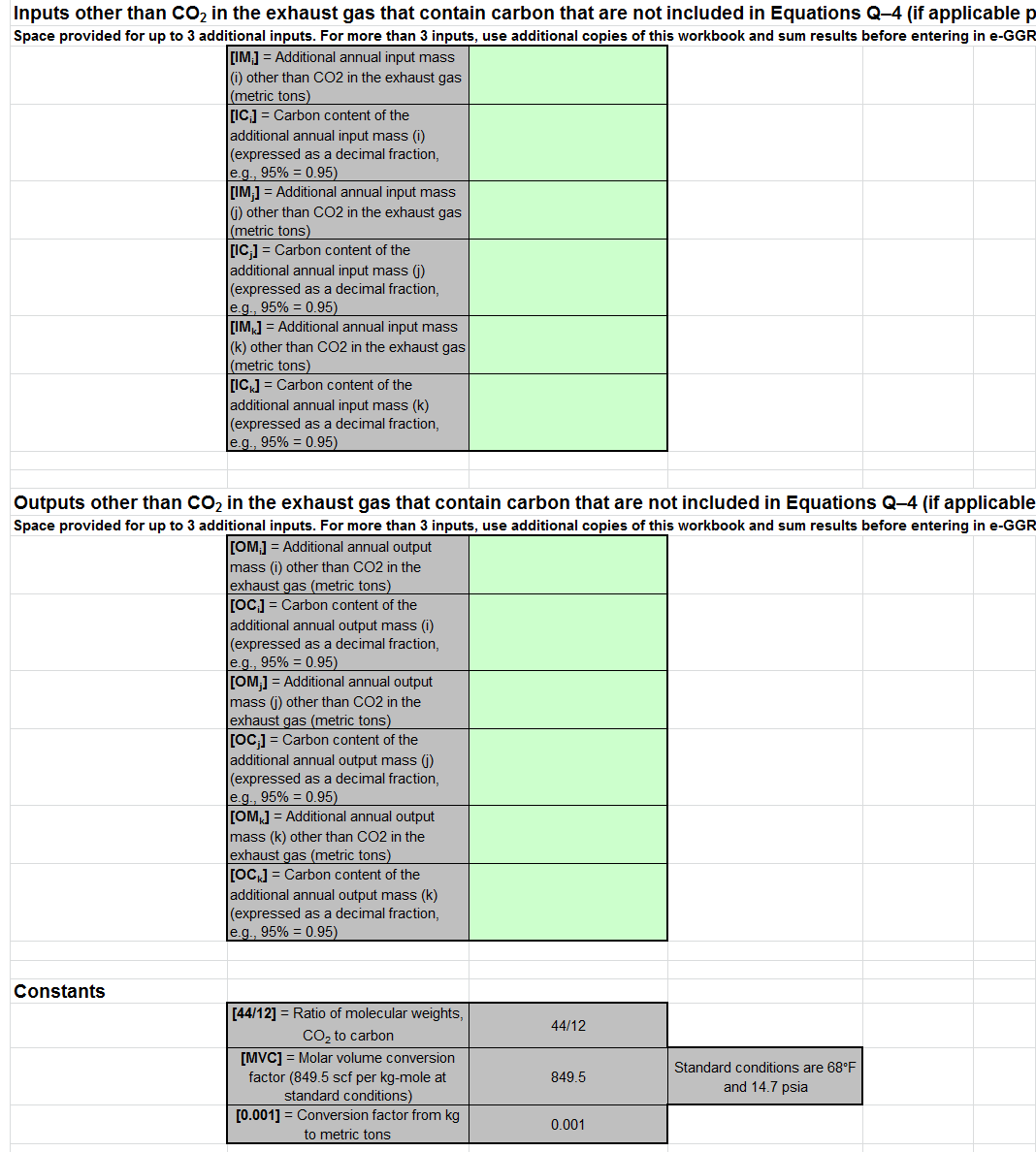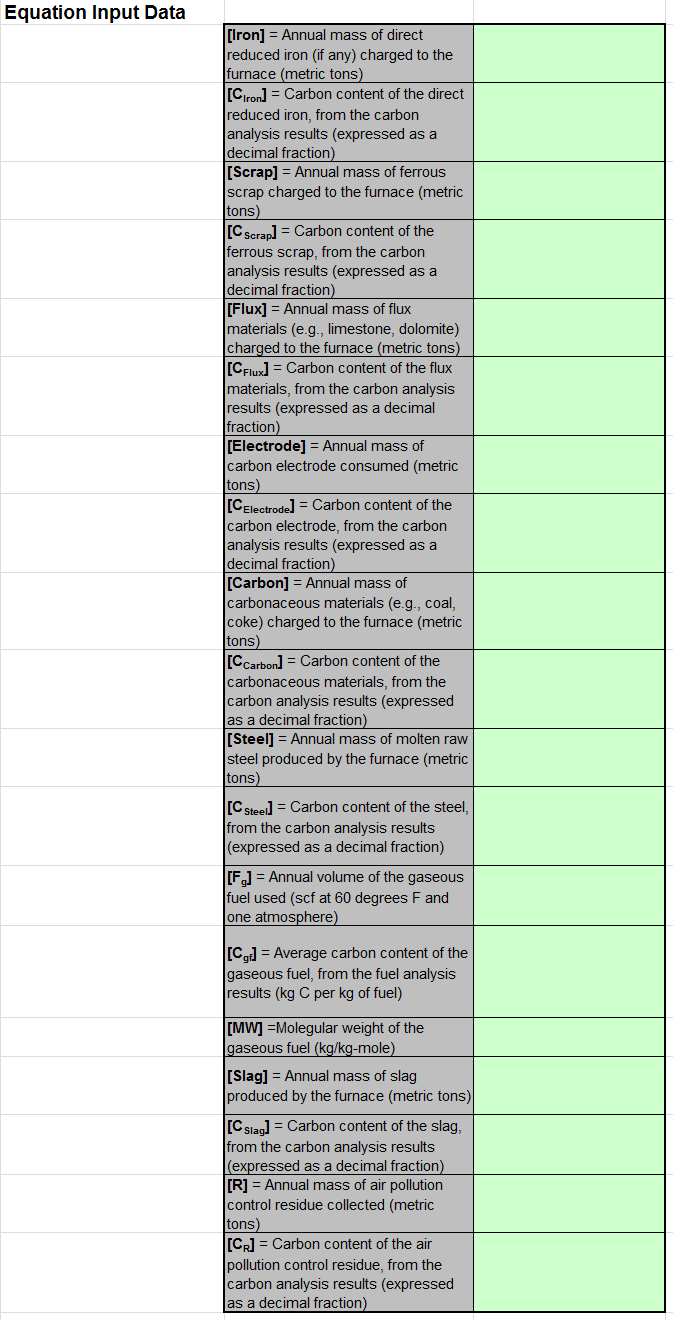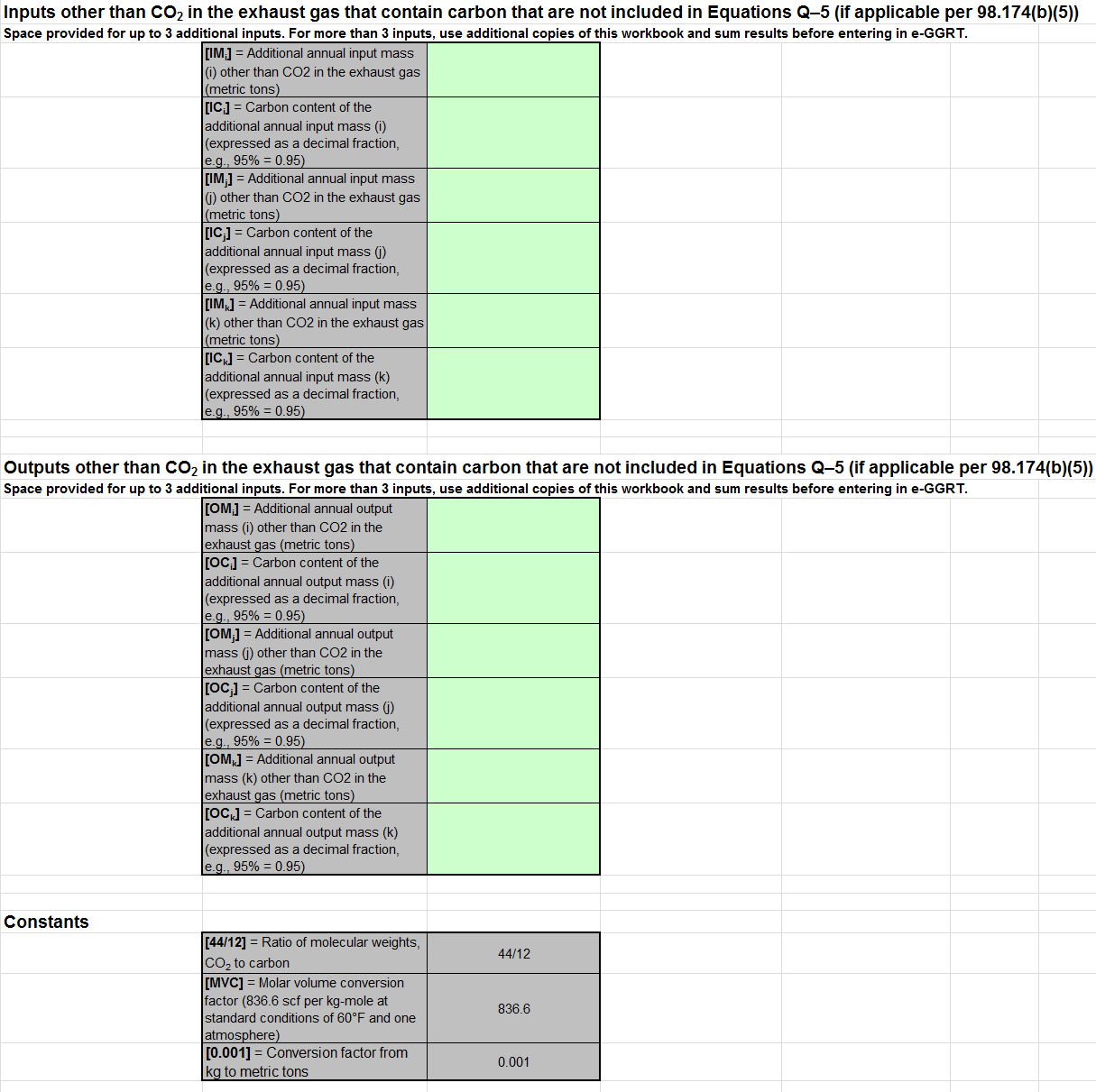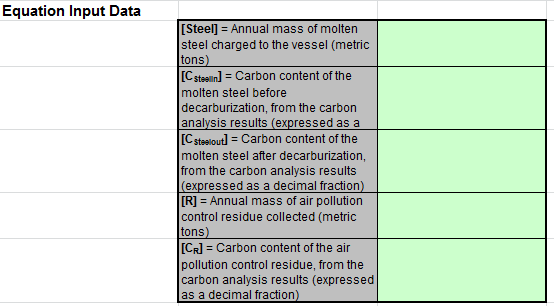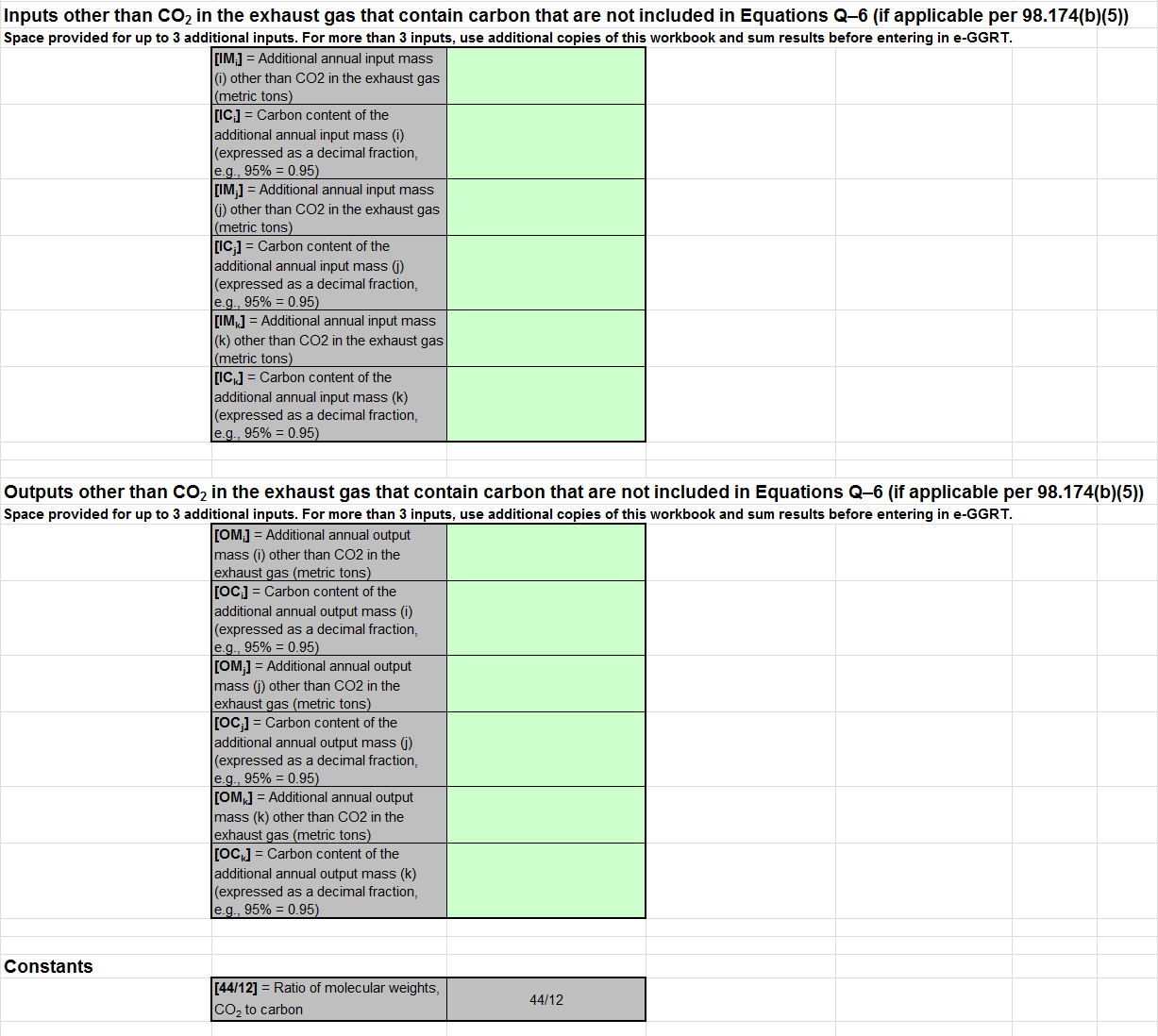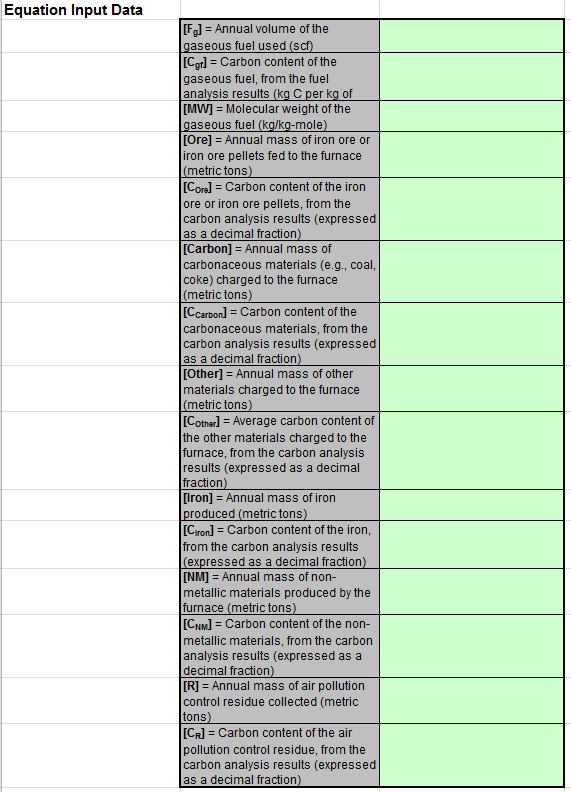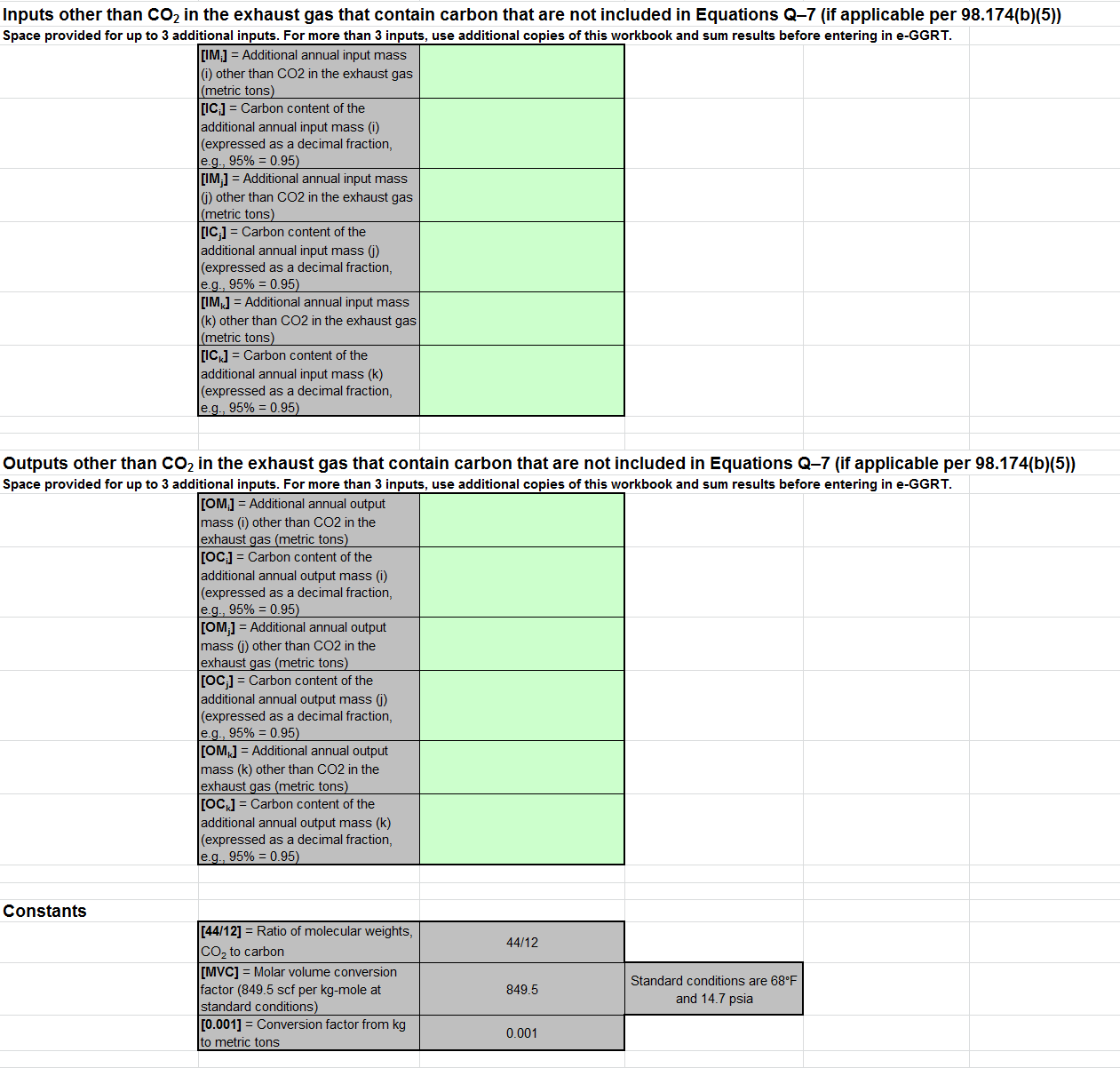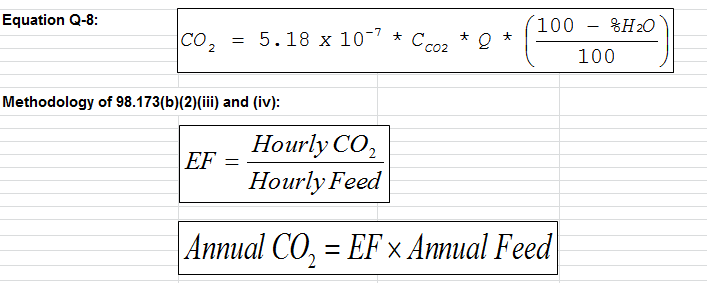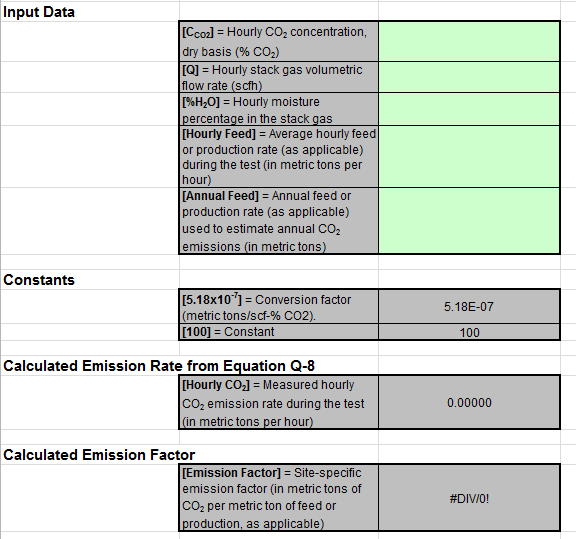These optional spreadsheets are provided to assist reporters in calculating emissions and in keeping records of these calculations.
Reporters are required to keep records of these calculations under 40 CFR 98.3(g) and additional subpart-specific provisions, but are not required to use these spreadsheets or to submit any spreadsheets to EPA.
Overview
This help page provides guidance for working with the supplemental Subpart Q calculation spreadsheets. The guidance provides step-by-step instructions for the following tasks:
- Selecting the Appropriate Calculation Spreadsheet
- Downloading a Calculation Spreadsheet
- General Information on Using a Calculation Spreadsheet
- Using the Equation Q-1 Calculation Spreadsheet
- Using the Equation Q-2 Calculation Spreadsheet
- Using the Equation Q-3 Calculation Spreadsheet
- Using the Equation Q-4 Calculation Spreadsheet
- Using the Equation Q-5 Calculation Spreadsheet
- Using the Equation Q-6 Calculation Spreadsheet
- Using the Equation Q-7 Calculation Spreadsheet
- Using the Equation EF Approach Calculation Spreadsheet
Specific information on each of the spreadsheets is provided below:
Calculation Spreadsheet | Calculation Method | Selection Criteria: | Instructions |
|---|---|---|---|
Carbon Mass Balance | Taconite indurating furnace | ||
Carbon Mass Balance | Basic oxygen process furnace | ||
Carbon Mass Balance | Non-recovery coke oven battery | ||
Carbon Mass Balance | Sinter process | ||
Carbon Mass Balance | Electric arc furnace (EAF) | ||
Carbon Mass Balance | Decarburization vessel | ||
Carbon Mass Balance | Direct reduction furnace | ||
Site-specific emission factor approach | Exhaust Stack |
Selecting the Appropriate Calculation Spreadsheet
Subpart Q requires facilities to report annual carbon dioxide (CO2) process emissions from each taconite indurating furnace, basic oxygen furnace, non-recovery coke oven battery, coke pushing process sinter process, electric arc furnace, decarburization vessel, and direct reduction furnace or from each exhaust stack used for iron and steel production. To calculate emissions, you may use the carbon mass balance method for each process unit (furnace, coke, oven battery, vessel, etc.), or the site-specific emission factor approach for each process unit used for iron and steel production.
Carbon Mass Balance Method
Carbon mass balance method calculations are based on the annual mass of inputs and outputs associated with the process and the annual average weight fraction of carbon in each input and output. Each process unit type has a unique Spreadsheet Tool for calculating emissions using the carbon mass balance method.
Equation Q--1 Calculation Spreadsheet. Use this spreadsheet to calculate annual CO2 emissions from a taconite indurating furnace used in iron and steel production. This spreadsheet performs the calculation using Equation Q-1, provided below:
(Equation Q-1) |
|---|
Equation Q--2 Calculation Spreadsheet. Use this spreadsheet to calculate annual CO2 emissions from a basic oxygen process furnace used in iron and steel production. This spreadsheet performs the calculation using Equation Q-2, provided below:
(Equation Q-2) |
|---|
Equation Q--3 Calculation Spreadsheet. Use this spreadsheet to calculate annual CO2 emissions from a non-recovery coke oven battery used in iron and steel production. This spreadsheet performs the calculation using Equation Q-3, provided below:
(Equation Q-3) |
|---|
Equation Q--4 Calculation Spreadsheet. Use this spreadsheet to calculate annual CO2 emissions from a sinter process used in iron and steel production. This spreadsheet performs the calculation using Equation Q-4, provided below:
(Equation Q-4) |
|---|
Equation Q--5 Calculation Spreadsheet. Use this spreadsheet to calculate annual CO2 emissions from an electric arc furnace used in iron and steel production. This spreadsheet performs the calculation using Equation Q-5, provided below:
(Equation Q-5) |
|---|
Equation Q--6 Calculation Spreadsheet. Use this spreadsheet to calculate annual CO2 emissions from a decarburization vessel used in iron and steel production. This spreadsheet performs the calculation using Equation Q-6, provided below:
(Equation Q-6) |
|---|
Equation Q--7 Calculation Spreadsheet. Use this spreadsheet to calculate annual CO2 emissions from a direct reduction furnace used in iron and steel production. This spreadsheet performs the calculation using Equation Q-7, provided below:
(Equation Q-7) |
|---|
Site-Specific Emission Factor Approach
Site-specific emission factor approach calculations are based on emission factors and feed rates derived from performance testing. Performance tests must measure CO2 emissions from all exhaust stacks for the process and measure either the feed rate of materials into the process, or the production rate from the process during the test.
EF Approach Calculation Spreadsheet. Use this spreadsheet to calculate annual CO2 emissions from each exhaust stack used in iron and steel production. This spreadsheet performs the calculation using the methodology described in 98.173(b)(2)(iii) and (iv) including the equations below:
(Equation Q-8 EF Approach - EF) |
|---|
(Equation Q-8 EF Approach - CO2) |
|---|
Downloading a Calculation Spreadsheet
Calculation spreadsheets for Subpart Q may be downloaded by clicking one of the links in the first column of the table below. Users may also jump to instructions for each spreadsheet by clicking one of the links in the fourth column.
Calculation Spreadsheet | Calculation Method | Selection Criteria: | Instructions |
|---|---|---|---|
Carbon Mass Balance | Taconite indurating furnace | ||
Carbon Mass Balance | Basic oxygen process furnace | ||
Carbon Mass Balance | Non-recovery coke oven battery | ||
Carbon Mass Balance | Sinter process | ||
Carbon Mass Balance | Electric arc furnace (EAF) | ||
Carbon Mass Balance | Decarburization vessel | ||
Carbon Mass Balance | Direct reduction furnace | ||
Site-specific emission factor approach | Exhaust Stack |
Using a Spreadsheet to Make Calculations
The guidance provided in this section applies to each of the calculation spreadsheet for Subpart Q. Additional guidance is provided for each individual spreadsheet in the sections below.
Color coding
The calculation spreadsheets contain green input cells, gray informational cells, and red-bordered results cells filled with yellow or white. Users should use green input cells to enter all data specific to their facility, unit, or process. Gray informational cells contain parameter names, column and row headings, equation constants and subtotals. Calculation results are displayed in red-bordered results cells filled with yellow or white. For red-bordered, yellow-filled results cells, the values in these cells should be entered in the appropriate and separate calculation spreadsheet (as directed below cell) where additional calculations will be made. For red-bordered, white filled results cells, the values in these cells should be entered in e-GGRT for the appropriate process units. All cells that are not green input cells are locked and cannot be modified.
|
Green input cell (data entry) |
|
Gray informational cells (locked) |
|
Red-bordered, yellow-filled results cells (enter in appropriate and separate calculation spreadsheet) |
|
Red-bordered, white filled results cells (enter in e-GGRT) |
Stop and Warning Messages
The calculation spreadsheets will display a stop message if the user enters a value that is invalid or a warning message if the user enters a value outside the EPA estimated range for a particular data element. For invalid data entries, the stop messages will not allow a user to proceed and the user must reenter valid data before moving forward. For data entries that are outside the EPA estimated range for a particular data element, the warning messages will allow a user to proceed if the user deems the entered value to be accurate.
Multiple Units or Processes
Users with multiple unit should use separate Spreadsheet Tools for each unit. Users should not aggregate data for multiple process types when using these Spreadsheet Tools.
Using the Equation Q-1 Calculation Spreadsheet
Use the Equation Q-1 Calculation Spreadsheet to calculate annual CO2 emissions from a taconite indurating furnace using the carbon mass balance method. Use a separate spreadsheet for each furnace. The Equation Q-1 Calculation Spreadsheet performs the calculations using Equation Q-1 provided below.
(Equation Q-1) |
|---|
Begin by entering the facility name, your name, the unit name or identifier, reporting period, and any additional comments in the green input cells of the general information table located immediately below the equation in the spreadsheet. This is for your records.
Next, enter the requested information in the green input cells in the Equation Data table.
If you have a process input or output other than CO2 in the exhaust gas that contains carbon that is not included in Equations Q--1, enter the carbon and mass rate of each additional process input or output in the provided additional green input cells.
The spreadsheet will calculate the annual CO2 emissions from this taconite indurating furnace. The calculated value will be displayed in the red-bordered cell at the bottom of the spreadsheet. This value should be entered in e-GGRT for this furnace.
Using the Equation Q-2 Calculation Spreadsheet
Use the Equation Q-2 Calculation Spreadsheet to calculate annual CO2 emissions from a basic oxygen process furnace using the carbon mass balance method. Use a separate spreadsheet for each furnace. The Equation Q-2 Calculation Spreadsheet performs the calculations using Equation Q-2 provided below.
(Equation Q-2) |
|---|
Begin by entering the facility name, your name, the unit name or identifier, reporting period, and any additional comments in the green input cells of the general information table located immediately below the equation in the spreadsheet. This is for your records.
Next, enter the requested information in the green input cells in the Equation Data table.
If you have a process input or output other than CO2 in the exhaust gas that contains carbon that is not included in Equations Q--2, enter the carbon and mass rate of each additional process input or output in the provided additional green input cells.
The spreadsheet will calculate the annual CO2 emissions from this basic oxygen process furnace. The calculated value will be displayed in the red-bordered cell at the bottom of the spreadsheet. This value should be entered in e-GGRT for this furnace.
Using the Equation Q-3 Calculation Spreadsheet
Use the Equation Q-3 Calculation Spreadsheet to calculate annual CO2 emissions from a non-recovery coke oven battery using the carbon mass balance method. Use a separate spreadsheet for each furnace. The Equation Q-3 Calculation Spreadsheet performs the calculations using Equation Q-3 provided below.
(Equation Q-3) |
|---|
Begin by entering the facility name, your name, the unit name or identifier, reporting period, and any additional comments in the green input cells of the general information table located immediately below the equation in the spreadsheet. This is for your records.
Next, enter the requested information in the green input cells in the Equation Data table.
If you have a process input or output other than CO2 in the exhaust gas that contains carbon that is not included in Equations Q--3, enter the carbon and mass rate of each additional process input or output in the provided additional green input cells.
The spreadsheet will calculate the annual CO2 emissions from this non-recovery coke oven battery. The calculated value will be displayed in the red-bordered cell at the bottom of the spreadsheet. This value should be entered in e-GGRT for this oven battery.
Using the Equation Q-4 Calculation Spreadsheet
Use the Equation Q-4 Calculation Spreadsheet to calculate annual CO2 emissions from a sinter process using the carbon mass balance method. Use a separate spreadsheet for each furnace. The Equation Q-4 Calculation Spreadsheet performs the calculations using Equation Q-4 provided below.
(Equation Q-4) |
|---|
Begin by entering the facility name, your name, the unit name or identifier, reporting period, and any additional comments in the green input cells of the general information table located immediately below the equation in the spreadsheet. This is for your records.
Next, enter the requested information in the green input cells in the Equation Data table.
If you have a process input or output other than CO2 in the exhaust gas that contains carbon that is not included in Equations Q--4, enter the carbon and mass rate of each additional process input or output in the provided additional green input cells.
The spreadsheet will calculate the annual CO2 emissions from this sinter process. The calculated value will be displayed in the red-bordered cell at the bottom of the spreadsheet. This value should be entered in e-GGRT for this sinter process.
Using the Equation Q-5 Calculation Spreadsheet
Use the Equation Q-5 Calculation Spreadsheet to calculate annual CO2 emissions from an electric arc furnace using the carbon mass balance method. Use a separate spreadsheet for each furnace. The Equation Q-5 Calculation Spreadsheet performs the calculations using Equation Q-5 provided below.
(Equation Q-5) |
|---|
Begin by entering the facility name, your name, the unit name or identifier, reporting period, and any additional comments in the green input cells of the general information table located immediately below the equation in the spreadsheet. This is for your records.
Next, enter the requested information in the green input cells in the Equation Data table.
If you have a process input or output other than CO2 in the exhaust gas that contains carbon that is not included in Equations Q--5, enter the carbon and mass rate of each additional process input or output in the provided additional green input cells.
The spreadsheet will calculate the annual CO2 emissions from this electric arc furnace. The calculated value will be displayed in the red-bordered cell at the bottom of the spreadsheet. This value should be entered in e-GGRT for this furnace.
Using the Equation Q-6 Calculation Spreadsheet
Use the Equation Q-6 Calculation Spreadsheet to calculate annual CO2 emissions from a decarburization vessel using the carbon mass balance method. Use a separate spreadsheet for each furnace. The Equation Q-6 Calculation Spreadsheet performs the calculations using Equation Q-6 provided below.
(Equation Q-6) |
|---|
Begin by entering the facility name, your name, the unit name or identifier, reporting period, and any additional comments in the green input cells of the general information table located immediately below the equation in the spreadsheet. This is for your records.
Next, enter the requested information in the green input cells in the Equation Data table.
If you have a process input or output other than CO2 in the exhaust gas that contains carbon that is not included in Equations Q--6, enter the carbon and mass rate of each additional process input or output in the provided additional green input cells.
The spreadsheet will calculate the annual CO2 emissions from this decarburization vessel. The calculated value will be displayed in the red-bordered cell at the bottom of the spreadsheet. This value should be entered in e-GGRT for this decarburization vessel.
Using the Equation Q-7 Calculation Spreadsheet
Use the Equation Q-7 Calculation Spreadsheet to calculate annual CO2 emissions from a direct reduction furnace using the carbon mass balance method. Use a separate spreadsheet for each furnace. The Equation Q-7 Calculation Spreadsheet performs the calculations using Equation Q-7 provided below.
(Equation Q-7) |
|---|
Begin by entering the facility name, your name, the unit name or identifier, reporting period, and any additional comments in the green input cells of the general information table located immediately below the equation in the spreadsheet. This is for your records.
Next, enter the requested information in the green input cells in the Equation Data table.
If you have a process input or output other than CO2 in the exhaust gas that contains carbon that is not included in Equations Q--7, enter the carbon and mass rate of each additional process input or output in the provided additional green input cells.
The calculation spreadsheet will calculate the annual CO2 emissions from this direct reduction furnace. The calculated value will be displayed in the red-bordered cell at the bottom of the spreadsheet. This value should be entered in e-GGRT for this furnace.
Using the Equation Q-8 EF Approach Calculation Spreadsheet
Use the Equation Q-8 EF Approach Calculation Spreadsheet to calculate annual CO2 emissions from an exhaust stack using the carbon mass balance method. Use a separate spreadsheet for each furnace. The Equation Q-8 EF Approach Calculation Spreadsheet performs the calculations using an equation to solve for the site-specific emission factor and an equation to calculate CO2 emissions. These equations are provided below.
|
|---|
|
|---|
Begin by entering the facility name, your name, the unit name or identifier, reporting period, and any additional comments in the green input cells of the general information table located immediately below the equation in the spreadsheet. This is for your records.
Next, enter the requested information in the green input cells in the Input Data table.
The spreadsheet will first calculate the site-specific emission factor for this stack and then use that value to calculate annual CO2 emissions from this exhaust stack. The calculated values will be displayed in the red-bordered cells at the bottom of the spreadsheet. These values should be entered in e-GGRT for this stack.








